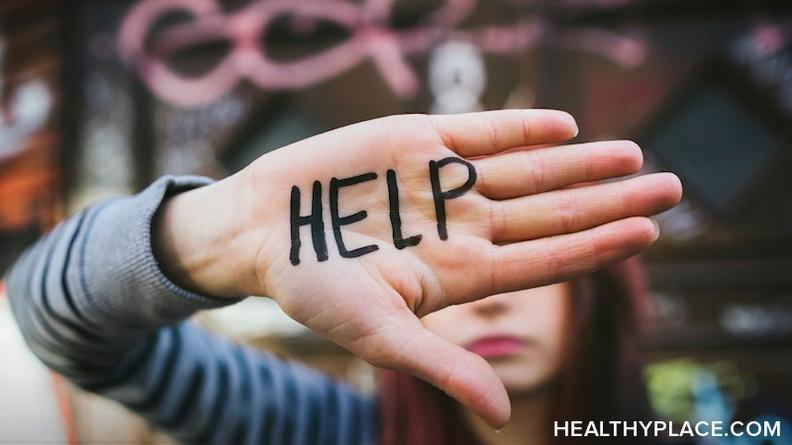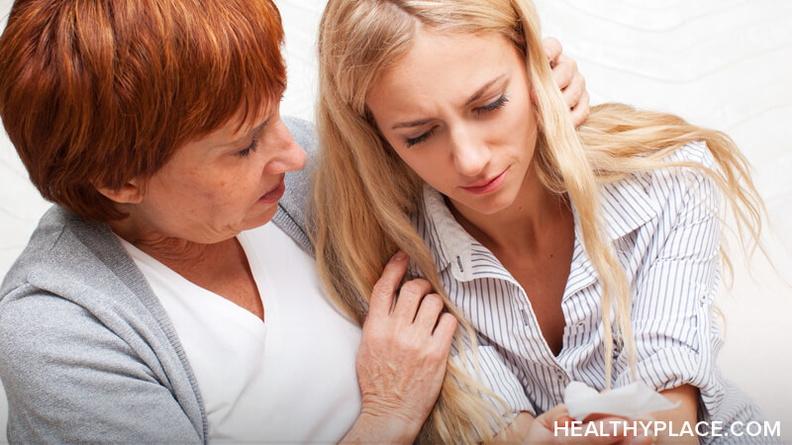Mental Health Hotline Numbers and Referral Resources

Mental Health hotline numbers for everything from alcohol treatment to panic disorder. Also National Alliance on Mental Illness (NAMI) and Mental Health America (MHA) state affiliate websites.
Suicide Hotline Phone Numbers
If you feel suicidal or you're in a crisis situation and need immediate assistance, people at these suicide hotlines in the U.S. are there to help. We have additional suicide information and resources here.
- 988 - Suicide and Crisis Lifeline (The old number will work indefinitely; it is 1-800-273-TALK [8255])
- 988, option 1 - VA Crisis Line
- 1-800-784-2433 (1-800-SUICIDE) - National Hopeline Network
- 1-866-488-7386 (1-866-4.U.TREVOR aimed at gay and questioning youth)
Just a note: These are resources that we have come across that may prove helpful to you. Please understand, we ARE NOT recommending or endorsing any of them. It is up to you to determine if they offer something you need and whether or not it is appropriate for your situation.
- Hotline Numbers
- National Alliance on Mental Illness (NAMI) - by State List
- Mental Health America (MHA) - by State List
- Non-Profits & Government. Agencies
- More Information on Mental Health by Topic
- Self-Help Clearinghouses by State
- Child Abuse & Neglect
- Missing Children
- NIH's Institutes
- Crisis Lines Outside the US
Hotline Numbers
Domestic Abuse and Child Abuse Hotline
- Child Abuse Hotline -- 800-4-A-CHILD (800 422 4453)
- National Domestic Violence Hotline -- 800-799-7233
- Missing & Exploited Children Hotline -- 1-800-843-5678
Drug and Alcohol
- National Council on Alcoholism and Drug Dependence (NCADD)-- 1-800-622-2255
- Partnership for Drug-Free Kids -- 1-855-DRUGFREE or text your message to 55753
- Substance Abuse and Mental Health Services Administration (SAMHSA) -- 1-800-662-4357
Eating Disorders
- National Eating Disorder Association (NEDA) HelpLine -- 1-800-931-2237 or text NEDA to 741741
- National Association of Anorexia Nervosa and Associated Disorders(ANAD) -- 630-577-1330
- Overeater’s Anonymous -- Click link to find a meeting near you
Learning Disabilities and ADHD
- Children & Adults with Attention Deficit/Hyperactivity Disorder Resource Center (CHADD) -- 1-800-233-4050
- National Center for Learning Disabilities -- 1-888-575-7373
Mental Health Crisis Lines / Suicide Hotlines
- Suicide and Crisis Lifeline -- 988
- Trevor HelpLine / Suicide Prevention for LGBTQ+ Teens -- 1-866-488-7386
- Crisis Text Line -- Text HOME to 741741
- Gay & Lesbian National Hotline -- 1-888-THE-GLNH (1-888-843-4564)
- IMAlive -- online crisis chat
- National Runaway Safeline -- 1-800-RUNAWAY (chat available on website)
- Teenline -- 310-855-4673 or text TEEN to 839863 (teens helping teens)
Rape and Sexual Assault
- Rape, Abuse, Incest, National Network (RAINN) -- 1-800-656-HOPE (1-800-656-4673)
- Sexual Abuse - Stop It Now! -- 1-888-PREVENT
STD / AIDS
- AIDS National Hotline -- 1-800-342-2437
- Project Inform HIV/AIDS Treatment Infoline -- 800-822-7422
- Project Inform Hepatitis C Helpline -- 1-877-435-7443
National Alliance on Mental Illness (NAMI)
1-800-950-NAMI (6264)
www.nami.org
NAMI State List:
Mental Health America (MHA)
(800) 969-6642
www.mentalhealthamerica.net
Mental Health America State List:
Non-Profit Groups for Illnesses & Disorders Government Agencies
-
AASK America/Aid to Adoption of Special Kids
http://www.aask.org/ -
The International Center for Disability Resources on the Internet
http://www.icdri.org/ -
Children's Hospice International
www.chionline.org -
Job Accommodation Network
www.jan.wvu.edu
-
American Autism Association
https://www.myautism.org/what-we-do/help-hotline/ -
National Easter Seal Society
http://www.easterseals.com/ -
Office for Civil Rights, U.S. Department of Education
http://www.ed.gov/about/offices/list/ocr/index.html -
PsychINFO American Psychological Association
http://www.apa.org/psycinfo/ -
Social Security Administration
http://www.ssa.gov/
More Information on Mental Health by Topic
AIDS
-
NPIN National Prevention Information Network
http://www.cdcnpin.org -
Centers for Disease Control and Prevention
http://www.cdc.gov/hiv/ -
AIDS Clinical Trials Info Service
http://www.aidsinfo.nih.gov/
ALCOHOL and DRUG ABUSE
-
National Council on Alcohol and Drugs
http://www.ncadd.org/ -
National Council on Alcoholism and Drug Dependence
http://www.ncaddnj.org/ -
National Council on Alcohol and Drugs
http://www.ncadd.org
ALZHEIMER'S DISEASE
-
Alzheimer's Association
http://www.alz.org/
-
Alzheimer's Disease Education and Referral Center
http://www.nia.nih.gov/Alzheimers/
ANXIETY / PANIC
- Panic Disorder Information Hotline -- 1-800-64-PANIC
BIPOLAR and DEPRESSION
- Depression and Bipolar Support Alliance (DBSA)
http://www.dbsalliance.org/
CHRONIC PAIN
- American Chronic Pain Association
http://www.theacpa.org/
DOMESTIC VIOLENCE
- National Domestic Violence Hotline
1-800-799-SAFE (24 hrs)
https://www.thehotline.org/
EATING DISORDERS
-
National Eating Disorder Referral and Information Center
International treatment referrals and prevention information
http://www.edreferral.com/ -
National Eating Disorders Association
International treatment referrals and information
http://www.nationaleatingdisorders.org/ -
Anorexia Nervosa and Associated Disorders (ANAD)
Referrals to treatment and Information
http://www.anad.org/ -
Massachusetts Eating Disorder Association, Inc Helpline
1-617-558-1881
Staffed by trained/supervised individuals. M-Friday 9:30-5:00pm. Wednesday evenings until 8:00pm
http://www.medainc.org/ - Food Addicts In Recovery Anonymous
http://www.foodaddicts.org/
GAMBLING
- National Council on Problem Gambling
http://www.ncpgambling.org/
LGBTQ+
- GLBT National Help Center
Gay, lesbian, bisexual and transgender national hotline
1-888-THE-GLNH (1-888-843-4564)
https://www.glbthotline.org/
MENTAL HEALTH
-
Mental Health America
(800) 969-6MHA
In crisis? Call 988
http://www.nmha.org/ -
National Alliance on Mental Illness
1-800-950-NAMI (950-6264)
http://www.nami.org/
SELF-HARM/SELF-ABUSE
- SAFE (Self-Abuse Finally Ends) Alternative
Information Line
800-DONT-CUT (366-8288)
https://selfinjury.com/
SEXUALLY TRANSMITTED DISEASES
- Center for Disease Control and Prevention
Sexually Transmitted Diseases
http://www.cdc.gov/std/
SUBSTANCE ABUSE/RECOVERY
-
Al-Anon / Alateen
http://www.al-anon.alateen.org/ -
National Council on Alcohol and Drugs
http://www.ncadd.org/ -
SAMHSA Substance Abuse Treatment Facility Locator
http://findtreatment.samhsa.gov/
For problems, issues or illnesses not listed above, contact the following:
-
National Mental Health Consumer's Self-Help Clearinghouse
1-800-553-4539
http://www.mhselfhelp.org/
Child Abuse and Neglect
- National Center for Missing & Exploited Children
1-800-THE-LOST (1-800-843-5678)
703-235-3900
www.missingkids.com -
Child Help USA
Info & referrals to local agencies; crisis counseling. Info & referrals to local agencies; crisis counseling.
1-800-4-A-CHILD (24 hrs)
www.childhelp.org/ -
National Council on Child Abuse & Family Violence
Info & referrals on child abuse & other types of family violence. Visit the website for your local toll-free numbers.
www.nccafv.org/ -
Child Welfare Information Gateway
www.childwelfare.gov/ -
Stop It Now1
Prevention of sexual abuse of children
1-800-PREVENT confidential line
www.stopitnow.org - Health Resources and Service Administration
The HRSA Information Center provides publications, information, resources, and referrals about health care services
www.ask.hrsa.gov -
National Center for Education in Maternal & Child Health
www.ncemch.org -
National Center for Victims of Crime
Resource and advocacy for crime victims. Stalking and dating violence resource centers
http://victimsofcrime.org/
Missing Children
-
Child Find of America
Prevention and resolution of child abduction
1-800-I AM LOST
www.childfindofamerica.org -
National Center for Missing & Exploited Children
Hotline: 1-800-THE-LOST (1-800-843-5678)
703-235-3900
www.missingkids.com -
National Runaway Switchboard
Keeps America's runaway and at-risk kids safe and off the streets
1-800-RUNAWAY
https://www.1800runaway.org/
Youth Issues/Problem Parenting
-
Covenant House NineLine
Referrals for youth or parents re: drugs, homelessness, runaways, etc. Message relays, reports of abuse. Helps parents with problems with their kids. If all counselors are busy, stay on the line & one will be with you as soon as possible.
1-800-999-9999 (24 hrs)
https://www.covenanthouse.org/
NIH'S INSTITUTES
-
National Institute on Alcohol Abuse and Alcoholism NIAAA
www.niaaa.nih.gov -
National Institute of Child Health and Human Development NICHD
www.nichd.nih.gov -
National Institute on Drug Abuse NIDA
301-443-1124
https://www.drugabuse.gov/ -
National Institute of Mental Health NIMH
1-866-615-6464
www.nimh.nih.gov -
National Center for Complementary and Alternative Medicine
1-888-644-6226
http://nccam.nih.gov
If you come across a group, organization or another resource you think should be listed here, please email us with the info. Also, if there's something we need to update, please let us know.
Crisis Lines Outside the U.S.
| Country | Hotline organization | Website | Phone number |
|---|---|---|---|
| Argentina | Centro de Asistencia al Suicida | www.asistenciaalsuicida.org | (011) 5275-1135 |
| Australia | Lifeline Australia | www.lifeline.org | 13 11 14 |
| Austria | TelefonSeelsorge Österreich | www.telefonseelsorge.at | 142 |
| Belgium | Centre de Prévention du Suicide | www.preventionsuicide.be | 0800 32 123 |
| Belgium | CHS Helpline | www.chsbelgium.org | 02 648 40 14 |
| Belgium | Zelfmoord 1813 | www.zelfmoord1813.be | 1813 |
| Brazil | Centro de Valorização da Vida | www.cvv.org | 188 |
| Canada | Crisis Services Canada | crisisservicescanada.ca | 833-456-4566 |
| Chile | Ministry of Health of Chile | www.hospitaldigital.gob | 6003607777 |
| China | Beijing Suicide Research and Prevention Center | www.crisis.org | 800-810-1117 |
| Costa Rica | Colegio de Profesionales en Psicología de Costa Rica | psicologiacr.com/aqui-estoy | 2272-3774 |
| France | SOS Amitié | www.sos-amitie.org | 09 72 39 40 50 |
| Germany | TelefonSeelsorge Deutschland | www.telefonseelsorge.de | 0800 1110111 |
| Hong Kong | Suicide Prevention Services | www.sps.org | 2382 0000 |
| India | iCall Helpline | icallhelpline.org | 9152987821 |
| Ireland | Samaritans Ireland | www.samaritans.org/how-we-can-help | 116 123 |
| Israel | [Eran] ער"ן | www.eran.org | 1201 |
| Italy | Samaritans Onlus | www.samaritansonlus.org | 800 86 00 22 |
| Japan | Ministry of Education, Culture, Sports, Science and Technology | www.mext.go.jp | 81-0120-0-78310 |
| Japan | Ministry of Health, Labour and Welfare of Japan | www.mhlw.go | 0570-064-556 |
| Malaysia | Befrienders KL | www.befrienders.org | 03-76272929 |
| Netherlands | 113Online | www.113.nl | 0800-0113 |
| New Zealand | Lifeline Aotearoa Incorporated | www.lifeline.org | 0800 543 354 |
| Norway | Mental Helse | mentalhelse.no | 116 123 |
| Pakistan | Umang Pakistan | www.umang.com.pk/ | 0311-7786264 |
| Philippines | Department of Health - Republic of the Philippines | doh.gov.ph/NCMH-Crisis-Hotline | 0966-351-4518 |
| Portugal | SOS Voz Amiga | www.sosvozamiga.org |
213 544 545 963 524 660 912 802 669 |
| Russia | Фонд поддержки детей, находящихся в трудной жизненной ситуации [Fund to Support Children in Difficult Life Situations] | www.ya-roditel.ru | 8-800-2000-122 |
| Singapore | Samaritans of Singapore | www.sos.org | 1-767 |
| South Africa | South African Depression and Anxiety Group | www.sadag.org | 0800 567 567 |
| South Korea | 중앙자살예방센터[Korea Suicide Prevention Center] | www.spckorea.or | 1393 |
| Spain | Teléfono de la Esperanza | www.telefonodelaesperanza.org | 717 003 717 |
| Switzerland | Die Dargebotene Hand | www.143.ch | 143 |
| Taiwan | 国际生命线台湾总会 [International Lifeline Taiwan Association] | www.life1995.org | 1995 |
| Ukraine | Lifeline Ukraine | lifelineukraine.com | 7333 |
| United Kingdom | Samaritans | www.samaritans.org/how-we-can-help | 116 123 |
| United States | 988 Suicide & Crisis Lifeline | 988lifeline.org | 988 |
APA Reference
Staff, H.
(2022, January 10). Mental Health Hotline Numbers and Referral Resources, HealthyPlace. Retrieved
on 2025, November 9 from https://www.healthyplace.com/other-info/resources/mental-health-hotline-numbers-and-referral-resources









